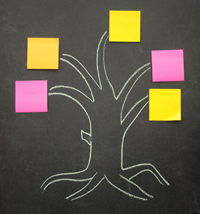By Reach Brands
If you want to innovate quickly and cheaply – ensuring a highly successful product launch – then visualising and prototyping is the only way to go. It has been proven by numerous studies and case histories that most entrepreneurs and inventors use the process of prototyping or visualising their ideas to innovate. And it really should be a vital part of your innovation process too.
Entrepreneurs and inventors undertake experiments – using trial and error, and taking little bets on unknowns. They learn ‘on the job’ and start work before they have all the answers. They use an evolutionary approach, learning as they go – rather than deciding the solution and then working out how to get there.
Take Google, for example. They experiment with new ideas all the time. So far in 2011 their big launches have been Google Offers and Google ‘Me on the Web’. Sometimes ideas are successful, really successful – like Adwords. And sometimes they are not – anyone remember Google Answers (2002-2006)? Either way, Google’s whole culture revolves around prototyping.
At Google, employees are positively encouraged to go ahead and develop their ideas through prototypes. They are used to get people excited internally about an idea and to create ‘flocking’ – encouraging the best resources to work on your project. ‘Googlers’ initially have to work through the bugs and barriers themselves by testing out ideas on friends and family. This would not be possible without prototyping and visualising.
Starbucks is another company that has embraced the principles of prototyping. In fact, originally Howard Schultz modeled his stores on the coffee houses he encountered in Italy. But over time The Starbucks Experience has been tweaked for an American audience. He has got rid of the baristas’ bow ties, the Italian menus and the permanent opera music. And in have come comfortable chairs, the relaxed atmosphere, etc.
So what are the key visualising and prototyping principles that all these dynamic innovators use?
- Visualise rough ideas – get things out fast and cheap, not looking pretty, and see what people think.
- Gather insights – get consumers/users to play and try things out.
- Get close – they get their hands dirty, observing or playing with consumers to find what is working and what isn’t.
- Keep it simple – break problems down into component parts or ‘smallify’ issues and get one thing right at a time.
- Modify – adopt learnings, have new ideas, try again and go back to creating some new, improved rough ideas to try out with consumers.
Procter & Gamble (P&G) adopted these principles as far back as the early 2000s. In the 80s and 90s P&G was known for its careful planning and for being risk adverse. Here is an extract of an interview with P&G’s Chris Thoen, Managing Director of Global Open Innovation:
“P&G has certainly had a mindset of being perfectionists. For a long time, we weren’t very comfortable doing that (prototyping) because it comes back to perfection: When we interact with consumers, it needed to be totally done. One of the biggest problems with unhealthy perfectionism is that so much time can pass before actually doing anything.”
‘Failing to learn fast’ or ‘failing forward’ is a key Silcone Valley operating principle. It can be applied not only to NPD but also brand positioning, brand design and advertising. It doesn’t have to be a ‘thing’ i.e. a product or service but any part of the communication mix.
At Reach we are keen advocates of these principles. Here are the reasons and benefits for taking a visualising/prototyping approach to ideas and concepts:
 1. Ignites and inspires
1. Ignites and inspires
 2. People learn by doing
2. People learn by doing
“For the things we have to learn before we can do them, we learn by doing them.” – Aristotle
Doing makes people think. As soon as we take an idea and start to visualise or build it, the brain starts to see issues that need resolving – or different angles that could be taken. Often in NPD workshops, clients that were either passionate or disinterested in an idea change their minds as it starts to be quickly worked up and brought to life.
 3. Brings brains together
3. Brings brains together
 4. It gets to the truth
4. It gets to the truth
When you show consumers ideas that are refined and look good, there is reticence to take them apart and criticise. However, if you show them something that is rough or at the workings stage, consumers think that ‘these people obviously need my help’. So they roll up their sleeves and get stuck in.
Designed and moderated in the right way, consumers feel that it is play or a game. They are so relaxed that insights come rolling out naturally and subconsciously – rather than being eked out of consumers through their rational and logical left-brain.
 5. Helps embrace new thinking
5. Helps embrace new thinking
 6. Problems are less overwhelming
6. Problems are less overwhelming
 7. Identifies and eliminates variables
7. Identifies and eliminates variables
 8. Creates buy-in
8. Creates buy-in
 9. Easier to change course
9. Easier to change course
- Ugly and cheap is just great. Perfect and beautiful is obsessive, time wasting and delusional as to the progress you are really making.
- It is fine to fail. In fact failure is really good as long as it’s done quickly and inexpensively – and you learn a lot.
- Accept that you and your team can’t know, and don’t have, all the answers. You can have hypotheses but don’t be attached to them. See where the journey takes you.
And finally, prototyping and visualisation is fun too. So, enjoy.
By Natalie Reed, Strategy Partner at Reach
 1. Ignites and inspires
1. Ignites and inspires 2. People learn by doing
2. People learn by doing 3. Brings brains together
3. Brings brains together 4. It gets to the truth
4. It gets to the truth 5. Helps embrace new thinking
5. Helps embrace new thinking 6. Problems are less overwhelming
6. Problems are less overwhelming 7. Identifies and eliminates variables
7. Identifies and eliminates variables 8. Creates buy-in
8. Creates buy-in 9. Easier to change course
9. Easier to change course